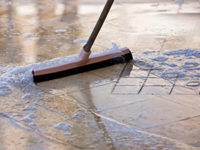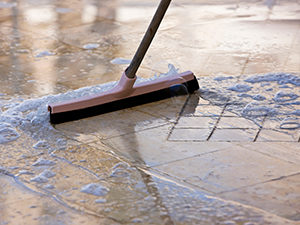A new stone or tile installation may have a slight film due to dust settling from construction or an inadequate cleanup of the grout residue. It is very important that excess grout be removed before it has a chance to cure. Check the specifications on the grout packaging for cure time.
If excess grout is left on the surface beyond the cure time, then use the following procedure:
Cement Grout Cleanup
1. Remove any large chunks of grout with a scraper. On polished stone, take care not to scratch the surface.
2. Sweep or dust mop floor to remove all loose debris.
3. Rinse the floor several times with plain water. Apply water with a string mop, wrung tightly. Avoid flooding the tile, as excessive water may cause discoloration of the grout. If too much water is applied, pick up excess with a wrung string mop or wet vacuum.
4. If grout residue still remains after several rinses it will be necessary to use a grout removing chemical as follows:
For marble and other acid sensitive stone:
Add 3-4 oz. of household ammonia to water and rinse the floor several times. There are also several non-acidic grout removers available.
For granite, glazed ceramic/porcelain:
Mix a mild solution of 2-4 oz. of sulfamic acid and water. Rinse the floor several times. Repeat rinsing with ammonia and water solution to remove acid residue. Do NOT use any other acids besides sulfamic acid. There are several grout cleaners available which contain sulfamic acid.
Do not use any acids on marble, travertine, onyx, limestone, or terrazzo!
Epoxy Grout Cleanup
Epoxy grouts are very different than cement based grout. They have excellent chemical resistance properties and are highly recommended for tile in kitchens and baths as well as counter tops and shower walls. Epoxy grouts can be tricky and working with them takes practice, so unless you have worked specifically with epoxy grouts before you may want to leave it to the professionals.
One of the biggest problems with epoxy grouts is failing to clean up the grout residue before it cures. Unlike cement based grouts, epoxy grout needs to be thoroughly cleaned in a much shorter time period or cleanup may prove difficult to impossible, depending on the surface type. If epoxy residue remains after it has cured the following procedure is recommended:
1. Carefully scrape any large pieces of epoxy from the surface using a sharp razor blade. Wetting the area first will help prevent scratching.
2. Mix a solution of hot water (the hotter the better) and several drops of dish washing detergent (Ivory, Dove, etc.). Apply the solution to the epoxy and scrub with a green scrub pad.
3. If the soap solution does not remove the epoxy, try wiping the surface with a clean white rag and acetone. (Be very careful to use all safety precautions when using acetone or other strong chemicals.)
4. If acetone fails, the epoxy will have to be removed with a stronger solvent.
The best approach to DIY projects is always precautionary rather than reactionary. If you are unsure about what grout cleaner or chemical to use or if a stronger solvent than those suggested here is required to resolve the problem, contact your stone and tile restoration contractor for recommendations or services.
This is one of a series of articles written and published on behalf of Stone and Tile PRO Partners.


